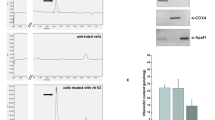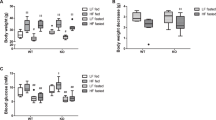Abstract
A NEW group of naturally occurring homologous quinones referred to as ubiquinone or coenzyme Q (Q 275) has been recognized in recent years1. Structural studies have led to the characterization of these compounds as derivatives of 2, 3,-dimethoxy, 5-methyl benzoquinone, substituted at position 6 with a polyisoprenoid side-chain1,2. Homologues with 6–10 side-chain isoprenoid units have been identified in animal and plant tissues and in micro-organisms3. While much interest has centred around its biological functions, little work has been done on the biosynthesis of ubiquinone. The incorporation of mevalonic acid into the isoprenoid chain has been recently reported4. The known participation of coenzyme A and acetate in the biosynthesis of mevalonic acid prompted a study of the possible relationship of dietary pantothenic acid to tissue-levels of ubiquinone.
This is a preview of subscription content, access via your institution
Access options
Subscribe to this journal
Receive 51 print issues and online access
$199.00 per year
only $3.90 per issue
Buy this article
- Purchase on Springer Link
- Instant access to full article PDF
Prices may be subject to local taxes which are calculated during checkout
Similar content being viewed by others
References
Morton, R. A., Nature, 182, 1764 (1958).
Shunk, C. H., Linn, B. O., Wong, E. L., Wittreich, P. E., Robinson, F. M., and Folkers, K., J. Amer. Chem. Soc., -80, 4753, 1958. Lester, R. L., Hatefi, Y., Widmer, C., and Crane, F. L., Biochim. et Biophys. Acta, 33, 169 (1959).
Lester, R. L., and Crane, F. L., J. Biol. Chem., 234, 2169 (1959).
Gloor, U., and Wiss, O., Arch. Biochem. Biophys., 83, 216 (1959).
Olson, R. E., and Kaplan, N. O., J. Biol. Chem., 175, 515 (1948).
Schneider, W. C., and Hogeboom, G. H., J. Biol. Chem., 183, 123 (1950).
Festenstein, G. N., Lowe, J. S., and Morton, R. A., Biochem. J., 59, 558 (1955).
Skeggs, H. R., and Wright, L. D., J. Biol. Chem., 156, 21 (1944).
Hoff-Jorgensen, E., “Methods of Biochemical Analysis”, 1, 81 (1954).
Pumphrey, A. M., Redfearn, E. R., and Morten, R. A., Chem. and Ind., 978 (1958). Joel, C. D., Karnovsky, M. L., Ball, E. G., and Cooper, O., J. Biol. Chem., 233, 1565 (1958). Crane, F. L., Lester, R. L., Widmer, C., and Hatefi, Y., Biochim. et Biophys. Acta., 32, 73 (1959) Basford, R. E., and Green, D. E., Biochim. et Biophys. Acta, 33, 185 (1959).
Radhakrishnamurthy, R., and Sarma, P. S., Arch. Biochem. Biophys., 67, 280 (1957).
Kasbekar, D. K., Lavate, W. V., Rege, D. V., and Sreenivasan, A., Biochem. J., 72 (in the press).
Author information
Authors and Affiliations
Rights and permissions
About this article
Cite this article
AIYAR, A., SULEBELE, G., REGE, D. et al. Pantothenic Acid Deficiency and Ubiquinone Levels in Rat Liver Mitochondria. Nature 184, 1867–1868 (1959). https://doi.org/10.1038/1841867b0
Issue Date:
DOI: https://doi.org/10.1038/1841867b0
This article is cited by
Comments
By submitting a comment you agree to abide by our Terms and Community Guidelines. If you find something abusive or that does not comply with our terms or guidelines please flag it as inappropriate.



